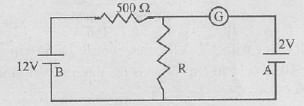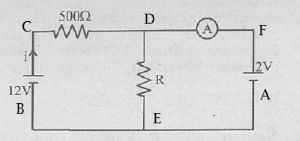VITEEE Physics Test - 8 - JEE MCQ
30 Questions MCQ Test - VITEEE Physics Test - 8
An electric motor operates on a 50 volt supply and a current of 12 A. If the efficiency of the motor is 30%, what is the resistance of the winding of the motor
Photons of energy 1eV and 2.5 eV successively illuminate a metal whose work function is 0.5 eV. The ratio of the maximum speeds of the electrons emitted will be
If a wire of resistance R is melted and recasted to half of its length, then the new resistance of the wire will be
Energy per unit volume for a capacitor having area A and separation d kept at potential difference V is given by
In the circuit,the galvanometer G shows zero deflection. If the batteries A and B have negligible internal resistance, the value of the resistor R will be

Given three equal resistors, how many different combination of all the three resistors can be made?
A proton is about 1840 times heavier than an electron. When it is accelerated by a potential difference of 1 kV, its kinetic energy will be
In an L-R circuit, time constant is that time in which current grows from zero to the value
Lenz's law is a consequence of the law of conservation of
On moving a charge of 20 C by 2 cm, 2 joule of work is done, then the potential difference between the points is
Two equal charges q of opposite sign separated by a distance 2a constitute an electric dipole of dipole moment p. If P is a point at a distance r from the centre of the dipole and the line joining centre to this point makes an angle θ with the axis of the dipole, then potential at the point P is given by
The capacitance of a parallel plate capacitor becomes 4/3 times its original value if a dielectric slab of thickness t = d/2 is inserted between the plates (where d is separation between the plates). The dielectric constant of the slab is
Five equal capacitors connected in series have a resultant capacitance of 4 μ F. The total energy stored in these, when these are connected in parallel and charged to 400V is
Two point charges of +4 μC and -6 μC are separated by a distance of 20 cm in air. At what point, on the line joining the two charges from charge +4 μC, the electric potential will be zero?
A potential difference of 2V exists across a potentiometer wire of 2m length. When the potential difference across a 2Ω resistance of a second circuit is measured by this potentiometer wire, it amounts to 5mm balancing length. The current in the second circuit is
In β + decay process, the following changes take place inside the nucleus
Sodium surface is subjected to ultraviolet and infrared radiations separately and the stopping potential of photoelectrons determined. Then the stopping potential is
An alpha nucleus of energy 1/2 mv2 bombards a heavy nuclear target of charge Ze. Then the distance of closest approach for the alpha nucleus will be proportional to
An image of the sun is formed by a lens of focal length 30 cm on the metal surface of a photoelectric cell and a photoelectric current (I) is produced. The lens forming the image is then replaced by another of the same diameter but of focal length of 15 cm. The photelectric current in this case is
If the luminous intensity of a unidirectional bulb is 100 candela, then total luminous flux emitted from the blub, is
A concave lens of focal length 20 cm placed in contact with a plane mirror acts as a
In case of a semiconductor which one of the following statements is wrong?
Platinum and silicon are heated upto 250oC and after then cooled. In the process of cooling
Which of the following, when added as an impurity atom in the silicon, produces n-type semiconductor?




















